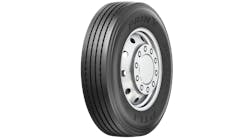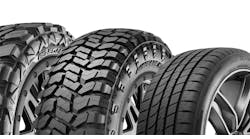Nobody can say that 2019 was a quiet year for the North American tire industry. And the new year is already shaping up to be equally action-packed as tire manufacturers, distributors and dealers continue to jockey for position in an increasingly unpredictable marketplace.
In this exclusive interview, John Healy, a managing director and research analyst with Cleveland, Ohio-based Northcoast Research Holdings LLC and author of MTD’s monthly Your Marketplace column, analyzes the year that was and discusses what 2020 will hold.
MTD: What was the most significant trend that emerged last year and how did that impact independent tire dealers?
Healy: To us, the story of 2018 seemed to be changes in distribution. In 2019, it seems like it was all about changes in manufacturing and where manufacturers built their product and installers sourced their inventory.
We noted major changes at companies like Cooper Tire & Rubber Co. This year, like other (tire makers), Cooper began to realign its manufacturing footprint in Asia with truck and bus radial (TBR) production moving from China to Vietnam. Goodyear Tire & Rubber Co. also made announcements of change, with modernization plans in facilities in Europe, as well as initial efforts at the company’s Gadsden, Ala., facility.
While some manufacturers were making changes, others were making announcements of new facilities. We saw new facility openings by Nokian Tyres plc and Bridgestone Americas Inc., as well as expansion plans by companies like Toyo Tire U.S.A. Corp. and Continental Tire the Americas LLC. Frankly, almost every tire manufacturer that we keep our eyes on made some sort of meaningful change to its production approach as the industry looks to bring down costs and also be closer to the end-market consumer, as the global trade landscape continues to be complicated.
MTD: When it comes to mergers and acquisitions, what do you foresee happening at the tire manufacturer, wholesale-distribution and retail levels in 2020? Do you see more tire maker-driven wholesale-distribution alliances, joint ventures, etc., like National Tire Wholesale (Michelin North America Inc. and Sumitomo Corporation of Americas) and TireHub (Bridgestone and Goodyear), forming? What about independent, wholesale distributor-driven partnerships like Tire Distributors of America LLC, which is owned by Max Finkelstein Inc. and Treadmaxx Tire Distributors Inc.? Has the wholesale-distribution channel reached a mergers and acquisition saturation point?
Healy: As it relates to mergers and acquisitions, we expect a mixed level of activity in 2020. As it relates to distribution alliances, we expect more stability than action on that front as alliances continue to be shaped and strategies going to market are firmed up and implemented. From our perspective, most of the alliances formed over the last two years are still in early stages of integration and customer acquisition/retention. We think it will be at least another year before more meaningful changes take place in the distribution world.
'We expect acquisitions of dealers will continue at a robust level.’
That said, we expect merger and acquisition activity at the tire dealer level to remain robust. We continue to see a very active Monro Inc., including this year’s efforts to move westward in terms of expansion efforts. Beyond Monro, there are multiple private equity groups which appear visible in their interests in assets. Looking to 2020, with an election on the horizon and another successful year in 2019, we think it’s reasonable that dealers might look to be more willing sellers than in years past.
MTD: Is there still a place for the smaller wholesale-distributor in today’s landscape? Why?
Healy: Without a doubt. From our perspective, two items still ring true today: people do business with people, and tires are sold more than they are bought. We view the choice to have your vehicle serviced is driven by two factors: price and confidence in the work. Given this, while large retailers or mega- dealer bases might be able to beat independents on price, there is no reason that they should consistently win on service levels. We believe treating the customer right and having a staff that is well- trained at the point of sale is key to winning for independents. Giving customers the information they need to confidently buy a tire is the ultimate goal, and we believe independents can do this as well as the big guys.
MTD: Monro continues to populate its geographic white space with strategic acquisitions. The company also is transitioning select locations to what it calls a more “tire-oriented” banner. What are your thoughts on Monro’s growth and branding strategy, particularly the chain’s push into the western U.S.? Do you think a point will arrive when Monro will ease off the accelerator when it comes to acquisitions?
Healy: Acquisitions have been a significant part of the growth strategy at Monro, and we do not see this changing. Over the past three years, Monro has spent roughly $230 million and completed the acquisition of 168 stores. This compares to around $360 million spent and 289 stores opened over the prior five-year period. So yes, the pace of acquisition has moderated some and the assets that have been acquired have pivoted a bit towards larger proprieties.
As it relates to what assets might be the most of interest to Monro, it’s always hard to tell. Recent efforts to establish itself in the western region (of the U.S.) seem logical as the company continues to move towards where the car population resides. That said, Monro is not forgetting about its business in the east. The acquisition of Free Tire Service in May 2018 was an example of a sizeable, quality operation acquired by Monro, which fits in nicely with existing operations. These types of acquisitions are still likely very much of interest to the company.
MTD: Greenbriar Equity Group/GB Auto Service has emerged as a big player, having made a number of high-profile independent tire dealer acquisitions over the last two years. Is the independent tire dealer market ripe for more private equity group activity?
Healy: Independent tire dealers, in our view, remain quality unique strategic assets. We expect acquisitions of dealers will continue to remain at a robust level as we believe private equity buyers look to expand and fill in geographical gaps as they build out scale.
From a big picture standpoint, servicing fleets as it relates to mobility offerings remains a strategic goal for a number of outfits. Having more geographical reach to be where the cars are located is a requirement.
Additionally, the economics of tire dealerships are still rather sound and can be enhanced with sourcing power and branding. Given this, scale and fit are always priorities for acquirers.
MTD: Amazon.com added tire installation to its check-out process in 2018 and since then has partnered with three retailers – Monro, Pep Boys – Manny, Moe & Jack and Sears Auto Centers – to build its nationwide installer network. Will we see independent tire dealers enroll as Amazon installers? What impact will Amazon have on our industry, both in the new year and long-term?
Healy: Theoretically, the potential is there for this to happen. Look at how Amazon is partnering with local level support for last-mile delivery. Getting the product to the customer and, in this case, the tires on the vehicle, is essential.
While we have not yet seen Amazon expand its direct partnerships with independent retailers, we do believe the potential exists. Do we see it happening in 2020? Our first reaction is, ‘Probably not,’ but we do see the potential for it over the long run.
Overall, we view the impact (of Amazon), to date, as very modest. Multiple times this year, we spent time surveying large retail outfits that have partnered with Amazon for installation. The results of our survey work would indicate that the average Sears location continues to do maybe five to 10 installations per week, with Monro and Pep Boys locations in the low single digits.
While we would be naive to think share will not shift online in time, we believe over the long-term that the economics of tire installation will be unchanged as installers earn more on the installation process.
MTD: Cooper and Sailun Vietnam Co. Ltd.’s joint venture in Vietnam recently produced its first truck tire. This past summer, China Manufacturers Alliance LLC announced that its Double Coin truck tire plant in Thailand had reached full capacity. During the 2019 Specialty Equipment Manufacturers Association Show, many Asian tire manufacturers touted the fact that their products are not made in China. Will companies continue to move truck tire production to other low-cost, southeast Asian countries due to tariffs imposed on Chinese-made truck tires? What other impacts will tariffs have on the truck tire market?
Healy: The situation and corresponding behavior of manufacturers continues to be rather fluid as it relates to China and tariffs. Over the last 18 to 24 months, the situation relating to tariffs has caused a meaningful level of sourcing changes, not just for tires but all facets of manufacturing.
We estimate that approximately 12 million tires being produced in China have shifted to other regions as manufacturers look to adapt profitability economics to the evolving global trade environment.
We are hopeful that the U.S. and China will agree to a longer-term economic framework that upholds the integrity of research and development, and the concepts of free and equitable trading. But to answer the question directly, we think that changes were made in 2019 and the benefits of these adjustments will be achieved in 2020.
Moving production from one country to another is not an easy, quick, or inexpensive undertaking. We believe recent changes in production flows will likely remain in place, even after a trade deal is struck.
We see vacated capacity in regions like China as being filled over the long run to service emerging demand growth in the region, as well as in parts of Europe.
Overall, we see global demand for tires growing modestly in mature markets and more robustly in emerging markets, as well as the size of tire fitments increasing, which reduces capacity. We see regions across Asia, including China, as areas where this capacity will likely be sourced.
MTD: Nokian recently opened its first-ever plant in the U.S. Toyo plans to expand annual production at its Bartow County, Ga., plant by more than one million tires. Continental’s new plant in Mississippi will start making truck tires in 2020. However, other tire makers have put investments in U.S. manufacturing plants on-hold for now. Will more off-shore-based tire manufacturers continue to invest in North American production facilities in 2020 or will we see more pullbacks?
Healy: Looking at 2019, we saw two major items: growth in the U.S. replacement tire market, and sourcing of tires globally become more complicated. We believe over the long run that emerging markets in Europe, Latin America, and Asia, which have been pockets of tire production, will increasingly become consumption markets, as well.
In the long run, we expect that the car population, miles driven, and the demand for tires in these markets will all outpace that of the more mature U.S. market.
We think a developing/continuing trend will likely be to produce products closer to where (companies) are selling product. Given this, and what could be a revival in manufacturing in the U.S., we see not only internationally domiciled, but also U.S.-domiciled, operators looking to have their U.S. production (located) in North America.
MTD: From your perspective, what is the overall health of American Tire Distributors Inc. (ATD) and its position in the marketplace, one year after bankruptcy? And how has ATD’s Tire Pros program been impacted by the last few years that ATD has experienced?
Healy: The situation at ATD has gone from critical to stable, and to now improving. We hear good things from dealers about service levels at ATD and hear from manufacturers that ATD is an important partner in their distribution.
As it relates to ATD’s Tire Pros program, our sense is that their business has continued to make improvements and strides. Locations have grown roughly by 3% compared to 2018.
MTD: Several tire manufacturers announced price hikes in 2019. Are these price increases sticking, and if so, why? Will tire makers continue to see an increase in raw material and other costs in 2020?
Healy: At a high level, we would (place)price actions over the last 12 months or so in two buckets: those relating to raw material-based increases on replacement consumer tires and those relating to TBR tires, as they related to tariffs. Largely speaking, we believe most of the price actions introduced in the fall of 2018 and early 2019 have been passed through dealers and absorbed by the customer.
That said, recent price hikes in the fall of 2019 appear to be less consistent than those that were introduced in the prior year. We have seen fewer manufacturers approach the market and have seen some modest increases in commentary from dealers on year-end bonuses/incentives, which may erode some of the price hikes.
MTD: How have dealers responded to the latest wave of price increases?
Healy: We have seen mixed reaction to recent price hikes, both from manufacturers and at retail. Given that raw material prices have shown some level of abatement over the past six months and two rounds of price actions have occurred over the last 18 months, we would not be surprised if we are in a holding pattern.
‘We have seen mixed reaction to recent price hikes, from manufacturers and at retail.’
We track key input costs to make a basic replacement tire. Our raw material tracker suggests that input costs in holding raws steady for 2020 would result in a raw material tailwind of 3.3% for tire manufacturers.
The biggest item that would make us move to a view that additional price actions are on the horizon for 2020 is if raw material prices move higher.
At this point, it’s too early to tell how they will move as the global environment remains uneven and demand trends, by geography, are mixed.
MTD: With the next U.S. presidential election less than one year away, what should independent tire dealers look — and listen — for during the upcoming election cycle?
Healy: Outside of weather conditions and unplanned maintenance needs, the health of the consumer is the driving force to automotive related spending. That will be key as we move into 2020. As we look at the last few election cycles, we note a trend of mixed results that show relatively no correlation between the industry and the lead-up to an election.
In assessing the 2016 time frame, we note replacement tire shipments for the industry were up 2.4% for the year, while increasing 6.1% in the three months leading up to the election. In assessing the 2012 time frame, we note that replacement tire shipments for the industry were down 1.9% for the year, while decreasing 2.7% in the three months leading up to the election. From this limited sample, it appears that the months preceding the election are a magnification of the trend seen for the whole year. Given this, we would urge dealers to watch the customer closely!
MTD: Let’s say you both retail and wholesale tires. If you only have time to pay attention to one thing that will affect your business in 2020, what is it and why?
Healy: Knowing the needs of your customer is always key to serving them well. I would closely monitor how the world of e-commerce is shaping trends in the tire retailing business. It would be naive to think that tires will not be a category that will be shaped in the future by factors relating to e-commerce.
Currently, we estimate 42% of tire buyers do research online for tires before purchasing, but only 7% of tire purchases are done over the web. We see this as a function of tires being sold and not bought — meaning the counter rep at the dealer’s location has a huge influence on the buying decision. Customers are still getting comfortable with the idea of buying tires online and having them installed at a physical location.
‘Only 7% of tire purchases are done over the web.’
Will this be the case in five years? That’s hard to know. We think it’s more likely than unlikely.
We think tire dealers should contemplate a future business analysis of how they can win by selling and installing tires, while also a scenario where are tires are bought online and dealers are utilized more for service and installation needs.
MTD: Thanks for the insights, John. ■




